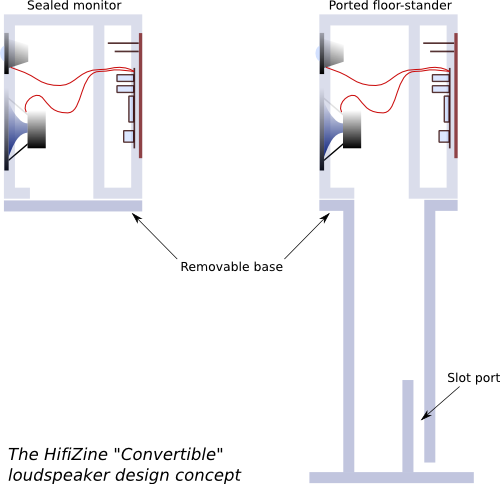The HifiZine Mini Convertible active speaker project – proposal
This is an alternate proposal to the HifiZine active 2-way loudspeaker project proposal using the miniDSP ICE-PWR125 two-way plate amp. This time, though, we’re looking at a smaller speaker – miniDSP told me that they designed the PWR-ICE125 plate amp to be as compact as possible, so I decided to get into the spirit of things and come up with proposal for a compact loudspeaker.
Of course, smaller speakers have less output and less bass. That is unavoidable. But, they may be easier for many people to build and/or more likely to find domestic acceptance. The goal here is to come up with a basic, documented starting point, with room for individual builders to experiment and share their construction notes and ideas. The ability to store multiple DSP configurations within the amps will I hope encourage experimentation and sharing of DSP configurations between builders.
I’ll start with the cabinet concept. I wanted to come up with something that can be used in either a sealed or ported configuration. The sealed version is a compact monitor, with the plate amp mounted on the back. The base plate of the monitor can be removed and replaced with a stand. This stand is hollow – thus making the cabinet larger – and has a port near the floor. Hey presto! A ported floor-standing loudspeaker.
The diagram below illustrates the concept with a cross-section through the speaker. The sealed monitor is on the left and the ported floor-stander is on the right. The plate amp has its own sub-enclosure to seal it from vibration within the cabinet.

What of the drivers? For the woofer, I’ve decided to use the Seas U16RCY/P, which has a frame diameter about that of a typical 5.5″ driver but a cone area about 25% higher (99 cm2):

In a sealed box, f3 is in the eighties, making it ideal for crossing to a subwoofer or for use in a small HT system. A Linkwitz transform in the amp can of course be used to drop the f3, subject to power and excursion limitations – this should work well in smaller rooms or on a bookshelf, even without a subwoofer. This driver could even be used in a box as small as 4 liters, although larger would be preferable.
With the ported base/stand attached, the low-frequency response depends on the total internal volume and the box/port tuning. For example, a volume of 14 litres gives an f3 of 45 Hz and an f10 of 33 Hz, while 22 litres with an EBS alignment gives an f3 of 35 Hz and an f10 around 28 Hz – albeit with slightly lower output capability.
For the tweeter, I’ve decided to use the Seas 27TBCD/GB-DXT, which has an unusual faceplate that helps control dispersion so that it should match well with the chosen woofer:

With these drivers, the smallest possible baffle size (using 18mm material to build) would be around 160×280 mm. Leaving a little room to breath and to allow for a roundover or chamfer, let’s call it 190×300 mm (7.5×11.8 in) for the baffle and around 300 mm deep including the sub-enclosure for the plate amp. The ported version would be set up so that the speaker is about 1 m (39″) tall.
Pricing works out as follows (driver prices as listed on Madisound):
- miniDSP PWR-ICE125 plate amp x 2: $550
- Seas U16RCY/P woofer x 2: $190
- Seas 27TBCD/GB-DXT tweeter x 2: $124
- Wood and finishing: $50+
Realistically, total build cost should work out around $1100 (USD, a bit more in Australia and other countries) including all parts and supplies, shipping, and a reasonable level of finish. Because of its size, it won’t be a “bass monster” or suitable for high output levels, but other than these natural limitations I’m expecting that this will be a neutral, easy-to-place, and very flexible/customizable little speaker.
In reverence to your previous tweeter choice: I have very pleasant experience with Monacor DT300+WG300 combo. It has decent sensitivity, smooth dispersion and nice dynamics. It is well damped around resonance unless modified (tried that – not worth it). I found it best sounding when placed as ‘naked’ on top of woofer box and manually aligned in time. Somehow this 17cm WG seem to be ‘magic’ in dispersion capability and interaction with the room though loses it when placed in wider baffle.
Regarding amp my guess is that you’ll need several subs to fill the room with bass most evenly. How are you going to do integration? Hypex has two-way plate amps with DSP that has controllable output for active sub. Going quickly through specs of Mini DSP’s PWR-ICE125 I don’t see this feature implemented.
Oh, I see a proposal for bass integration here: https://johnr.hifizine.com/2013/08/the-tandem-subwoofer/
Still you can only use sub that has AES/EBU digital input and must tune it separately. Anyway, good luck with your project!
Hi Janis, thank you for the comments on the DT300/WG300, sorry about the delay getting back to you. I expect I will use it for a project at some time. With regard to the plate amps and subwoofer integration, yes, I’m assuming in that article that the miniDSP plate amp is also in the sub(s). All amps on the network appear in the interface and it takes only a few seconds to switch between them. I like this concept but you are quite right, there may be difficulties if wanting to use existing subs.